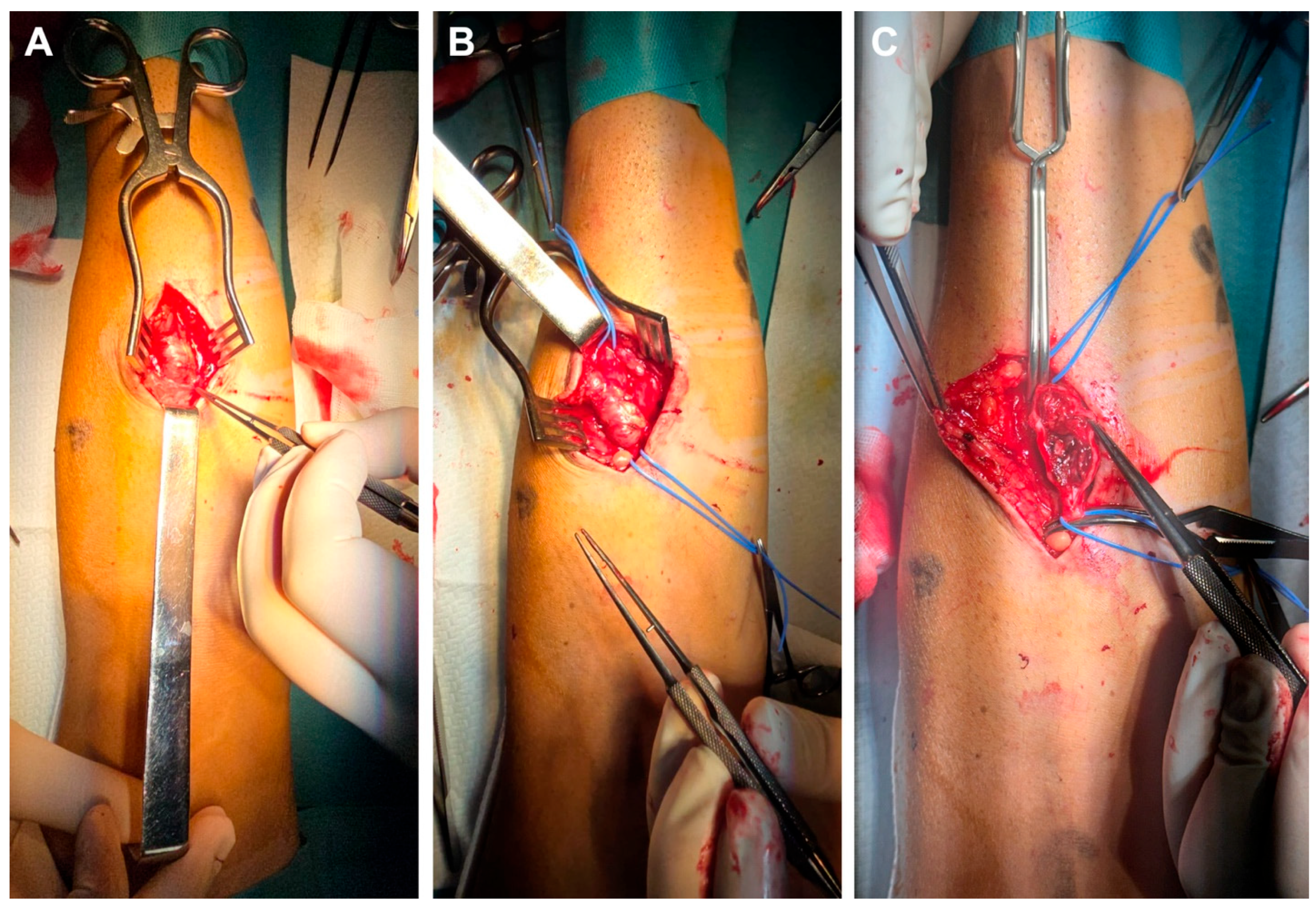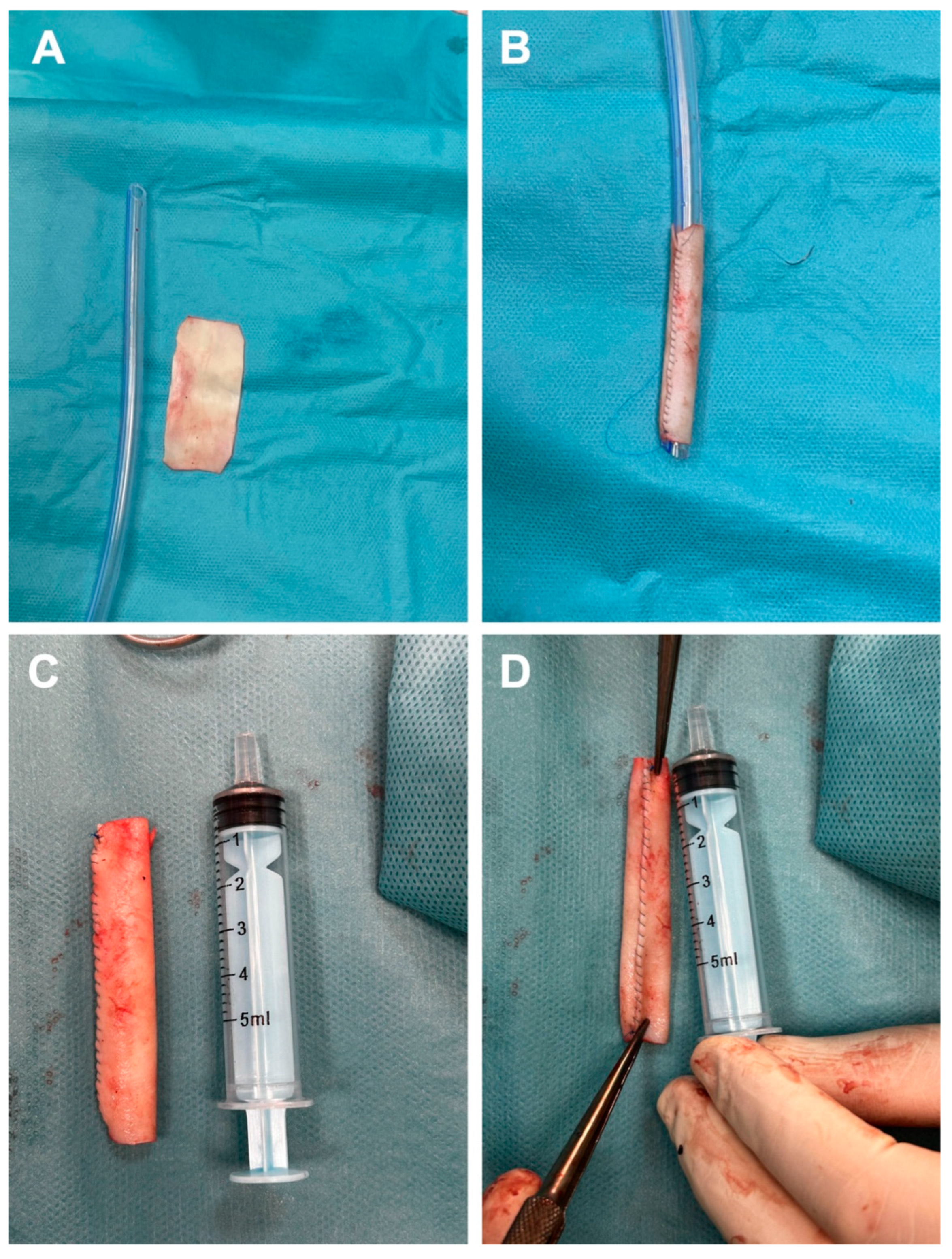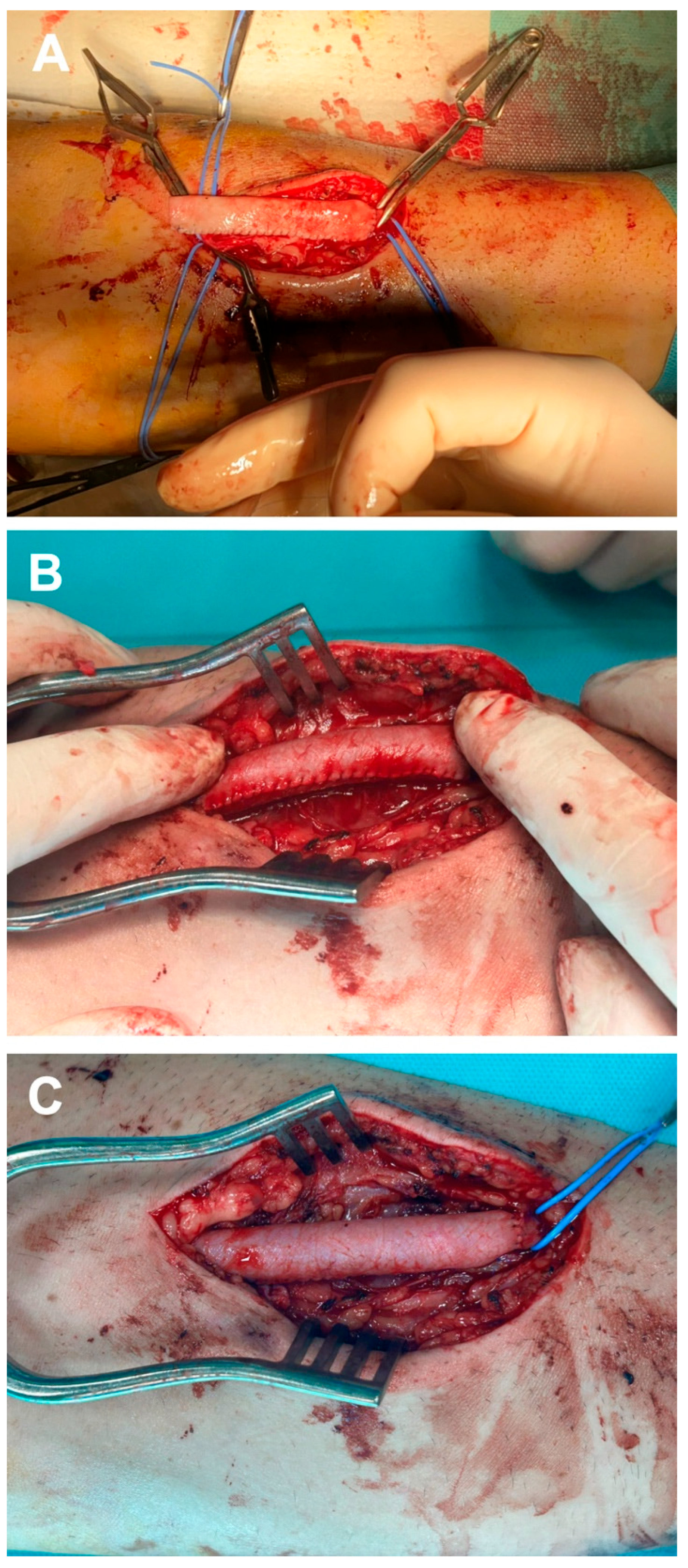Reconstruction of a Thrombosed Aneurysmal Radio-Cephalic Arteriovenous Fistula with a Tubular Bovine Pericardial Conduit
Abstract
1. Introduction
2. Case Report
3. Discussion
4. Conclusions
Author Contributions
Funding
Institutional Review Board Statement
Informed Consent Statement
Data Availability Statement
Acknowledgments
Conflicts of Interest
Abbreviations
| VA | vascular access |
| ESKD | end-stage kidney disease |
| RC-AVF | radio-cephalic arteriovenous fistula |
| IH | intimal hyperplasia |
| CKD | chronic kidney disease |
| ECM | extracellular matrix |
References
- Schmidli, J.; Widmer, M.K.; Basile, C.; de Donato, G.; Gallieni, M.; Gibbons, C.P.; Haage, P.; Hamilton, G.; Hedin, U.; Kamper, L.; et al. Editor’s Choice—Vascular Access: 2018 Clinical Practice Guidelines of the European Society for Vascular Surgery (ESVS). Eur. J. Vasc. Endovasc. Surg. 2018, 55, 757–818. [Google Scholar] [CrossRef]
- Inston, N.; Mistry, H.; Gilbert, J.; Kingsmore, D.; Raza, Z.; Tozzi, M.; Azizzadeh, A.; Jones, R.; Deane, C.; Wilkins, J.; et al. Aneurysms in Vascular Access: State of the Art and Future Developments. J. Vasc. Access 2017, 18, 464–472. [Google Scholar] [CrossRef]
- Heindel, P.; Yu, P.; Feliz, J.D.; Hentschel, D.M.; Burke, S.K.; Al-Omran, M.; Bhatt, D.L.; Belkin, M.; Ozaki, C.K.; Hussain, M.A. Radiocephalic Arteriovenous Fistula Patency and Use: A Post Hoc Analysis of Multicenter Randomized Clinical Trials. Ann. Surg. Open 2022, 3, e199. [Google Scholar] [CrossRef]
- Kim, H.K.; Kwon, T.-W.; Cho, Y.-P.; Moon, K.-M. Outcomes of Salvage Procedures for Occluded Autogenous Radiocephalic Arteriovenous Fistula. Ther. Apher. Dial. 2011, 15, 448–453. [Google Scholar] [CrossRef]
- Kordzadeh, A.; ISRAF Collaborators; Mohaghegh, V.; Inston, N. International Survey of Radiocephalic Arteriovenous Fistula: ISRAF Survey. J. Vasc. Access 2025, 26, 477–486. [Google Scholar] [CrossRef]
- Chan, P.G.; Goh, G.S. Safety and Efficacy of the AngioJet Device in the Treatment of Thrombosed Arteriovenous Fistula and Grafts: A Systematic Review. J. Vasc. Access 2018, 19, 243–251. [Google Scholar] [CrossRef] [PubMed]
- Lambert, G.; Freedman, J.; Jaffe, S.; Wilmink, T. Comparison of Surgical and Radiological Interventions for Thrombosed Arteriovenous Access. J. Vasc. Access 2018, 19, 555–560. [Google Scholar] [CrossRef] [PubMed]
- Pourriyahi, H.; Pourriahi, H.; Najd Sepas, H. Salvage Aneurysmorrhaphy as an Adaptable and Still Pertinent Technique in the Management of Challenging True Aneurysms of Arteriovenous Fistulas: A Case Series of Different Variations, With Illustrative Surgical Pictures. EJVES Vasc. Forum 2024, 61, 126–131. [Google Scholar] [CrossRef] [PubMed]
- Płoński, A.; Płoński, A.F.; Głowiński, J. Surgical Management, Prevention and Outcomes for Aneurysms of Arteriovenous Dialysis Fistulas: A Case Series Study and Review. Int. J. Environ. Res. Public Health 2023, 20, 6256. [Google Scholar] [CrossRef] [PubMed]
- Arbănaşi, E.-M.; Russu, E.; Mureşan, A.V.; Arbănaşi, E.-M.; Kaller, R. Ulnar-Basilic Arteriovenous Fistula with Multilocular Gigantic Aneurysmal Dilatation: A Case Report. Acta Marisiensis-Ser. Medica 2021, 67, 244–246. [Google Scholar] [CrossRef]
- Kaller, R.; Mureșan, A.V.; Arbănași, E.M.; Arbănași, E.M.; Kovács, I.; Horváth, E.; Suciu, B.A.; Hosu, I.; Russu, E. Uncommon Surgical Management by AVF between the Great Saphenous Vein and Anterior Tibial Artery for Old Radiocephalic AVF Failure. Life 2022, 12, 529. [Google Scholar] [CrossRef]
- Hejna, E.E.; Chang, J.; Terranella, S.L.; Trawczynski, M.H.; Hollinger, E.F.; Jensik, S.C.; Olaitan, O.; Hertl, M.; Chan, E.Y. End-to-End Anastomosis as a Superior Repair Type to Prevent Recurrence of Arteriovenous Fistula Aneurysms and Improve Patency Outcomes. J. Vasc. Access 2024, 25, 531–537. [Google Scholar] [CrossRef]
- Piccolo, C.; Madden, N.; Famularo, M.; Domer, G.; Mannella, W. Partial Aneurysmectomy of Venous Aneurysms in Arteriovenous Dialysis Fistulas. Vasc. Endovasc. Surg. 2015, 49, 124–128. [Google Scholar] [CrossRef]
- Wang, S.; Wang, M.S. Successful Use of Partial Aneurysmectomy and Repair Approach for Managing Complications of Arteriovenous Fistulas and Grafts. J. Vasc. Surg. 2017, 66, 545–553. [Google Scholar] [CrossRef]
- Wan, Z.; Lai, Q.; Zhou, Y.; Chen, L.; Tu, B. Partial Aneurysmectomy for Treatment of Autologous Hemodialysis Fistula Aneurysm Is Safe and Effective. J. Vasc. Surg. 2019, 70, 547–553. [Google Scholar] [CrossRef] [PubMed]
- Parker, M.H.; Hashemi, H.; Grant, C.; Colpitts, D.K.; Kfoury, E.; Mukherjee, D.; Neville, R. A Novel Technique Using Long Segment Patch Angioplasty Maturation to Increase the Maturation Rate of Arteriovenous Fistulas. J. Vasc. Surg. 2021, 74, 230–236. [Google Scholar] [CrossRef]
- Fisher, O.; Meecham, L.; Buxton, P.; Legge, J.; Fairhead, J.; Rajagopalan, S.; Asquith, J.; Pherwani, A. Long-Term Outcomes of Bovine Pericardial Patch Angioplasty for Recurrent Stenosis in Vascular Access: A UK Single-Centre Experience. J. Vasc. Access 2018, 19, 658–662. [Google Scholar] [CrossRef]
- Sowa, P.; Halandras, P.; Blecha, M. The Safety of Bovine Tissue Arterial Repair in Removal of Infected Prosthetic Hemodialysis Grafts. J. Vasc. Access 2021, 22, 470–474. [Google Scholar] [CrossRef] [PubMed]
- Katzman, H.E.; Schild, A.F.; Vanderwerf, B.A. Bovine artegraft arteriovenous fistulas for hemodialysis in one-hundred patients after “conventional” arteriovenous fistulas failed. Vasc. Surg. 1976, 10, 169–175. [Google Scholar] [CrossRef]
- Harlander-Locke, M.; Jimenez, J.C.; Lawrence, P.F.; Gelabert, H.A.; Derubertis, B.G.; Rigberg, D.A.; Farley, S.M. Bovine carotid artery (Artegraft) as a hemodialysis access conduit in patients who are poor candidates for native arteriovenous fistulae. Vasc. Endovasc. Surg. 2014, 48, 497–502. [Google Scholar] [CrossRef] [PubMed]
- Pineda, D.M.; Dougherty, M.J.; Wismer, M.C.; Carroll, C.; Tyagi, S.; Troutman, D.A.; Calligaro, K.D. Bovine carotid artery xenografts for hemodialysis access. J. Vasc. Surg. 2017, 65, 1729–1734. [Google Scholar] [CrossRef]
- Kostakis, I.D.; Loukopoulos, I. Comparison between bovine carotid artery graft and polytetrafluoroethylene graft for haemodialysis vascular access: A systematic review and meta-analysis. J. Vasc. Access 2021, 22, 26–33. [Google Scholar] [CrossRef] [PubMed]
- Marcus, P.; Echeverria, A.; Cheung, M.; Kfoury, E.; Shim, K.; Lin, P.H. Early Cannulation of Bovine Carotid Artery Graft Reduces Tunneled Dialysis Catheter-Related Complications: A Comparison of Bovine Carotid Artery Graft Versus Expanded Polytetrafluoroethylene Grafts in Hemodialysis Access. Vasc. Endovasc. Surg. 2019, 53, 104–111. [Google Scholar] [CrossRef] [PubMed]
- Kraai, T.W.; Looman, R.S.; Drouven, J.W.; Gareb, B.; Saleem, B.R.; Zeebregts, C.J. Bovine Carotid Artery Grafts versus PTFE grafts for hemodialysis access: A systematic review and meta-analysis. Ann. Vasc. Surg. 2025, 122, 486–500. [Google Scholar] [CrossRef] [PubMed]
- Aziz, M.; Albert, P.; Connelly, Z.M.; Lairmore, T.C.; Virk, C. A Retrospective Review of Bovine Artery Graft Patency: A Single-Site Study. Ann. Vasc. Surg. 2023, 94, 272–279. [Google Scholar] [CrossRef] [PubMed]
- Abdoli, S.; Mahajan, A.; Han, S.M.; Rowe, V.L.; Katz, S.G.; Ochoa, C.J. Early cannulation of bovine carotid artery grafts (Artegraft) after primary vascular access and fistula revision procedures. J. Vasc. Surg. 2018, 68, 1865–1871. [Google Scholar] [CrossRef]
- GnanaDev, R.; Malkoc, A.; Jeney, A.B.; Mikael, A.; Andacheh, I. A Multicenter Analysis of Revision of Aneurysmal Dialysis Access Using Bovine Carotid Artery Conduit. Ann. Vasc. Surg. 2023, 97, 399–404. [Google Scholar] [CrossRef]
- Balaz, P.; Björck, M. True Aneurysm in Autologous Hemodialysis Fistulae: Definitions, Classification and Indications for Treatment. J. Vasc. Access 2015, 16, 446–453. [Google Scholar] [CrossRef]
- Valenti, D.; Mistry, H.; Stephenson, M. A Novel Classification System for Autogenous Arteriovenous Fistula Aneurysms in Renal Access Patients. Vasc. Endovasc. Surg. 2014, 48, 491–496. [Google Scholar] [CrossRef]
- DuBose, J.J.; Azizzadeh, A. Utilization of a Tubularized Cormatrix Extracellular Matrix for Repair of an Arteriovenous Fistula Aneurysm. Ann. Vasc. Surg. 2015, 29, 366.e1–366.e4. [Google Scholar] [CrossRef]
- DuBose, J.J.; Fortuna, G.R.; Charlton-Ouw, K.M.; Saqib, N.; Miller, C.C.; Estrera, A.L.; Safi, H.J.; Azizzadeh, A. Utility of a Tubularized Extracellular Matrix as an Alternative Conduit for Arteriovenous Fistula Aneurysm Repair. J. Vasc. Surg. 2016, 63, 446–452. [Google Scholar] [CrossRef][Green Version]
- Leskovar, B.; Furlan, T.; Poznic, S.; Hrastelj, M.; Adamlje, A. Using CorMatrix for Partial and Complete (Re)Construction of Arteriovenous Fistulas in Haemodialysis Patients: (Re)Construction of Arteriovenous Fistulas with CorMatrix. J. Vasc. Access 2019, 20, 597–603. [Google Scholar] [CrossRef] [PubMed]
- Meecham, L.; Fisher, O.; Kirby, G.; Evans, R.; Buxton, P.; Legge, J.; Rajagopalan, S.; Asquith, J.; Pherwani, A. Simultaneous Iliac Vein Bovine Pericardial Patch Venoplasty and Creation of PTFE Lower Limb Arteriovenous Fistula Graft for Rescue Vascular Access. Ann. Vasc. Surg. 2016, 36, 292.e9–292.e11. [Google Scholar] [CrossRef] [PubMed]
- Bae, M.; Kim, J. Tongue patch angioplasty for small-caliber vein segments directly connected to juxta-anastomotic stenosis. J. Vasc. Access 2025, 26, 1036–1040. [Google Scholar] [CrossRef] [PubMed]
- Trinh, K.N.; Wilson, S.E.; Gordon, I.L.; Williams, R.A. Postintervention Patency: A Comparison of Stenting versus Patch Angioplasty for Dysfunctional Hemodialysis Access Sites. Ann. Vasc. Surg. 2016, 33, 120–125. [Google Scholar] [CrossRef]




Disclaimer/Publisher’s Note: The statements, opinions and data contained in all publications are solely those of the individual author(s) and contributor(s) and not of MDPI and/or the editor(s). MDPI and/or the editor(s) disclaim responsibility for any injury to people or property resulting from any ideas, methods, instructions or products referred to in the content. |
© 2025 by the authors. Licensee MDPI, Basel, Switzerland. This article is an open access article distributed under the terms and conditions of the Creative Commons Attribution (CC BY) license (https://creativecommons.org/licenses/by/4.0/).
Share and Cite
Ujlaki-Nagi, A.-A.; Szanto, L.-A.; Florea, E.; Lazar, N.-A.; Șincaru, S.-V.; Mureșan, A.V.; Russu, E.; Bartus, R.; Arbănași, E.-M.; Hosu, I.; et al. Reconstruction of a Thrombosed Aneurysmal Radio-Cephalic Arteriovenous Fistula with a Tubular Bovine Pericardial Conduit. Kidney Dial. 2025, 5, 46. https://doi.org/10.3390/kidneydial5030046
Ujlaki-Nagi A-A, Szanto L-A, Florea E, Lazar N-A, Șincaru S-V, Mureșan AV, Russu E, Bartus R, Arbănași E-M, Hosu I, et al. Reconstruction of a Thrombosed Aneurysmal Radio-Cephalic Arteriovenous Fistula with a Tubular Bovine Pericardial Conduit. Kidney and Dialysis. 2025; 5(3):46. https://doi.org/10.3390/kidneydial5030046
Chicago/Turabian StyleUjlaki-Nagi, Alexandru-Andrei, Ludovic-Alexandru Szanto, Elena Florea, Nicolae-Alexandru Lazar, Suzana-Vasilica Șincaru, Adrian Vasile Mureșan, Eliza Russu, Réka Bartus, Eliza-Mihaela Arbănași, Ioan Hosu, and et al. 2025. "Reconstruction of a Thrombosed Aneurysmal Radio-Cephalic Arteriovenous Fistula with a Tubular Bovine Pericardial Conduit" Kidney and Dialysis 5, no. 3: 46. https://doi.org/10.3390/kidneydial5030046
APA StyleUjlaki-Nagi, A.-A., Szanto, L.-A., Florea, E., Lazar, N.-A., Șincaru, S.-V., Mureșan, A. V., Russu, E., Bartus, R., Arbănași, E.-M., Hosu, I., Harpa, M. M., Ciucanu, C. C., & Arbănași, E.-M. (2025). Reconstruction of a Thrombosed Aneurysmal Radio-Cephalic Arteriovenous Fistula with a Tubular Bovine Pericardial Conduit. Kidney and Dialysis, 5(3), 46. https://doi.org/10.3390/kidneydial5030046






